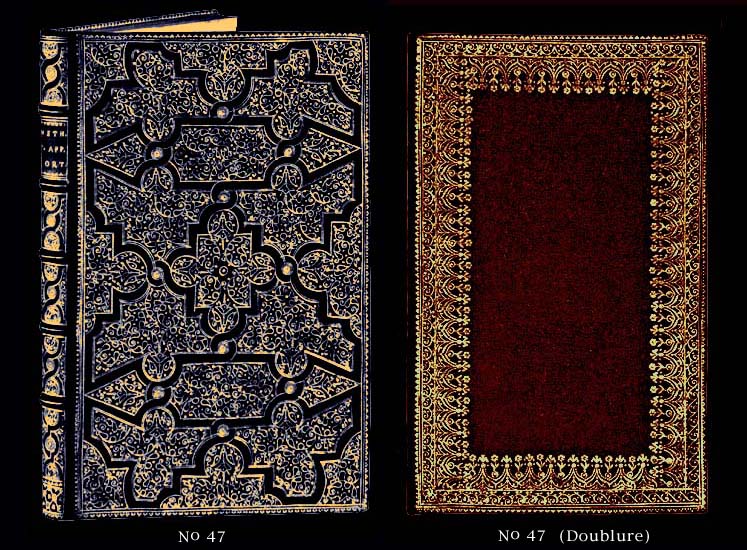

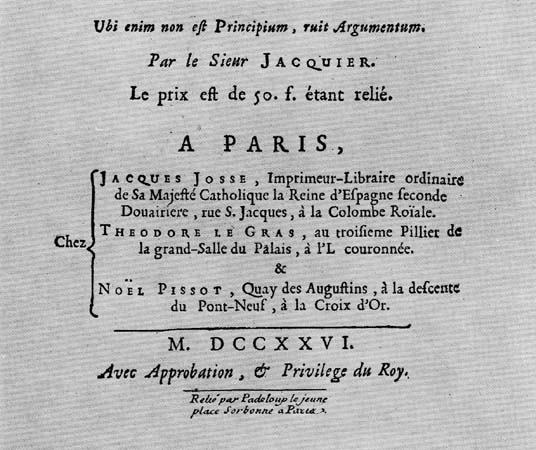

|
The Padeloup binding, shown above, is No. 47 in Raphaël Esmerian's second volume 2eme Partie: Reliures de quelques ateliers du XVII Siècle & Livres en divers genres du XVIIe et XVIIIe Siècles, from his 6 volume, 1972-74 publication entitled Bibliotheque Raphael Esmerian. This is possibly one of the most important published examples of Padeloups work. Esmerian presents this binding with its inner doublure as well as a photograph of Padeloup's 'ticket' on the title-page: Relié par Padeloup le juene place de la Sorbonne à Paris. Esmerian's photographs of this binding are in black and white, and it is described as being made of Blue Morocco with an inner doublure of Red Morocco. I have added some colour to these photos in an attempt to give a better idea of this work.
In Herbert P. Horne's 1894 publication entitled The binding of Books we find an excellent initial summary of this extraordinary master-binder.
To these biographical notes we must now add the fascinating details found in Esmerian's short preamble to presenting two important Padeloup bindings. The chapter is titled: ATELIER ANTOINE MICHEL PADELOUP, dit LE JEUNE 1685-1758. Esmerian notes that Padeloup apprenticed in his Father's workshop and had established his own business by 1712 a la Place Sorbonne à Paris. In this substantial, well equipped workshop, he employed a number of binders and guilders. It may be that Antoine Michel's roll in the production of the workshop was mainly that of overseeing and directing the work. Whatever the case may be, his merit was great, for, in the history of bookbinding, no other workshop produced as many high quality elegant volumes , decorated with such a variety of original styles, all perfectly executed. Esmerian explains that, in this publication he will not be detailing Padeloup's harmonious dentelles or beautiful mosaiques 'floral ou a repetition' that are always found, in pleasant hues agreeable to the eye, but rather, he will present two representative examples of mosaique bindings that have been decorated with pointillé tooling. Then we come to a most interesting observation; some of the pointillé tools used by Padeloup are said by Esmerian, to have come from the ateliers of Rocolet. This will be the next step in our research, to verify this claim by a comparative study using the proved methodology of high resolution digital imagery. By a stroke of good fortune, I have managed to acquire an original Padeloup binding which will serve as a reliable source of imprint examples. |
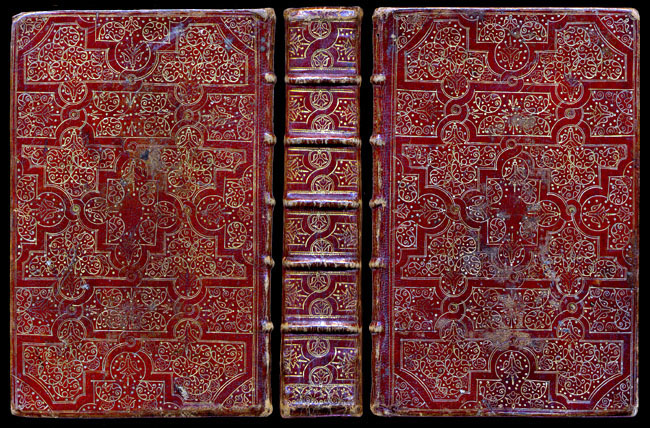
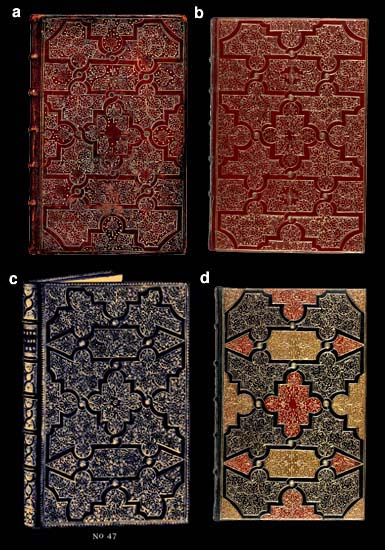
|
In comparative Diagram 1, we see 4 very similar Padeloup bindings; (a) Office de la Semaine Sainte, Latin et Fran┴ois A Paris, chez Antoine Dezallier, 1701. (b) OSS, 1701, found in the Bristish Library Database of Bookbindings Shelfmark Davis531. click this link to go to the BLDB enlargement (c) Jacquier, Methode tres aisee pour Apprendre L'Orthographie - Paris. J. Josse 1726. (Esmerian No. 47) (d) Homilies ou sermons Paris, 1693. Bristish Library Database of Bookbindings Shelfmark Davis533 (1728?) click this link to go to the BLDB enlargement |
| These four bindings are so similar that we may imagine them to have all been made around the same period as the 1726 example. Fortunately one of Padeloup's favorite decorative tools has a small defect that is easily spotted. This makes most of his bindings very easy to recognize. |
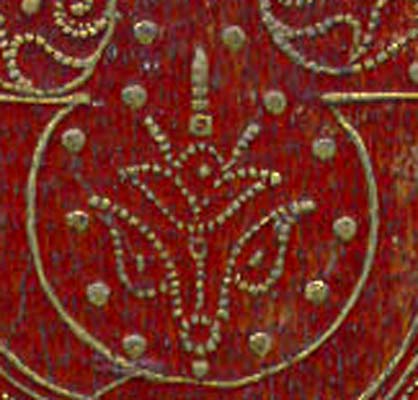
| In the magnified imprint, shown above, which is from my specimen (a), we see that there is a gap or missing bead in the segmentation of the right petal of the fleuron (very close to the center). I have named this fleuron pj-1, (short form of Padeloup le jeune - 1) as it plays a significant and central roll in many of the bindings and compares easily, in form and function, with md-1 of the Maitre Doreur work. In this exceptionally clean imprint example, we can observe that pj-1 has many more unusual characteristics which will enable it to be identified easily: the angular deflection of the base of the stem, the unusual segment at the base of the right antenna, the squared crowning ring, to name a few. |
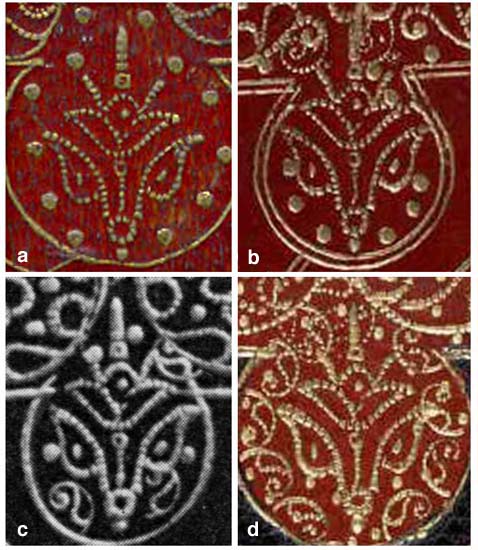
|
In Comparative Diagram 2, we find four pj-1 imprint examples, all shown at the same scale. Even though the quality of each imprint is quite different, the identifying characteristics are plainly evident. Thus we can claim with a good measure of confidence that these imprints all derive from the same tool and thus that the bindings are all from the Atelier of Antoine Michel Padeloup. I would like to just point out here that imprint quality plays a major role in the identification of imprints and that bindings that have been decorated with pointillé tools could be graded by the quality of the imprints. We may never know who actually guilded these bindings, however there appears to be a marked difference in the application of the gold tooling. Whether or not these differences are in fact due to variations in environmental conditions is another point to consider. However I want to just point out what I feel to be the important differences, and the imprints in this diagram provide us with an interesting range of quality, not forgetting that the quality of the reproduced image is also to be considered: i.e., only imprint (a) is an actual 200 dpi scan; (b) is a photo with a resolution equivalent of less than 300 dpi; (c) is a scan of a printed photo and even though a high resolution scan (600 dpi), the result is probably less than 200 dpi quality; (d) is from a photo and is of the same quality as (b). These differences in reproduction quality are more evident in the enlargement. Getting beyond the limits of reproduction quality, we come to the more important issue of imprint quality. Notice that the pj-1 imprint (a) has very clear segmentation; thus, I would rate this as high quality work. There is another possibility of similarly clear segmentation which is when the imprint actually lacks the correct amount of deposited gold. I suppose we could define this more simply by imagining that the force applied by the guilder to the tool to make the impression was too light (or possibly the tool not hot enough), whereas in our imprint example (c) the opposite effect, where too much gold has been left in the imprint and the segmentation is not so clear. In fact, we see that the bottom ring, at the base of the fleuron no longer shows any segmentation at all. This I would rate as of secondary quality. Parts of imprint (d) appear smudged or doubled, as though the hand of the guilder perhaps slipped or trembled while making this impression. This is then work of a lesser quality although we must consider if the example is an isolated accident. The main issue I think, therefore, is too much gold or not enough, and that pointillé bindings can be classed by the perfection or quality of the imprint, clarity of the segmentation as well as the uniform application of the tooling i.e. too much gold in the imprints may be acceptable if all the tooling appears to be of the same weight. Such is the case of Esmerian's example No. 47 where the application of the gold appears to be excessive but uniform. Finally, I must address the question of individual preference. Esmerian has noted that Padeloup developed his own set of new pointillé tools, these he claimed were designed to have a more striking appearance. Personally, I think that it may be that the tools were not so much different, but that their application was, i.e. there was a tendency to aspire to the 'more gold effect'. The guilder was perhaps, deliberately trying to add more gold even at the expense of pointillé detail. Next Page: Pointillé tools from the Atelier of Antoine Michel Padeloup. |
| Go to Digital Alchemy | return to the home page of cyclopaedia.org |